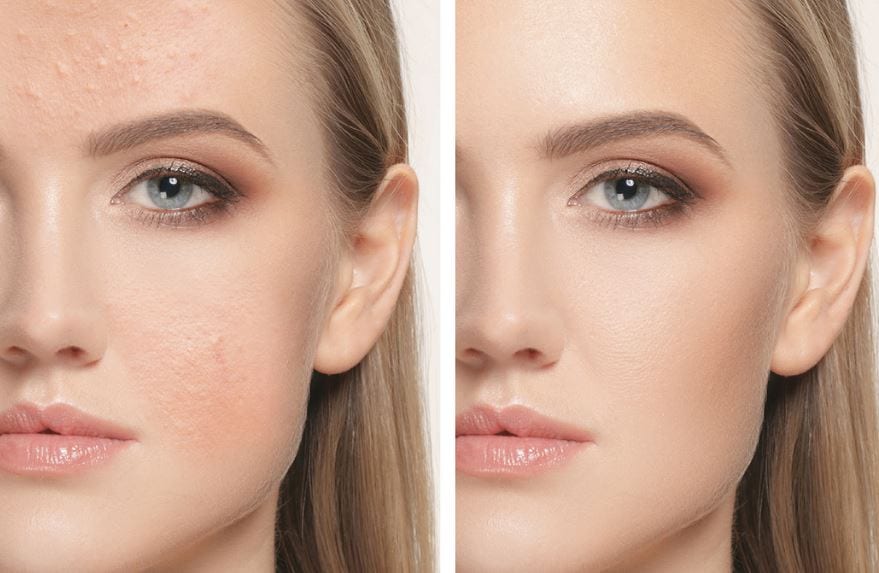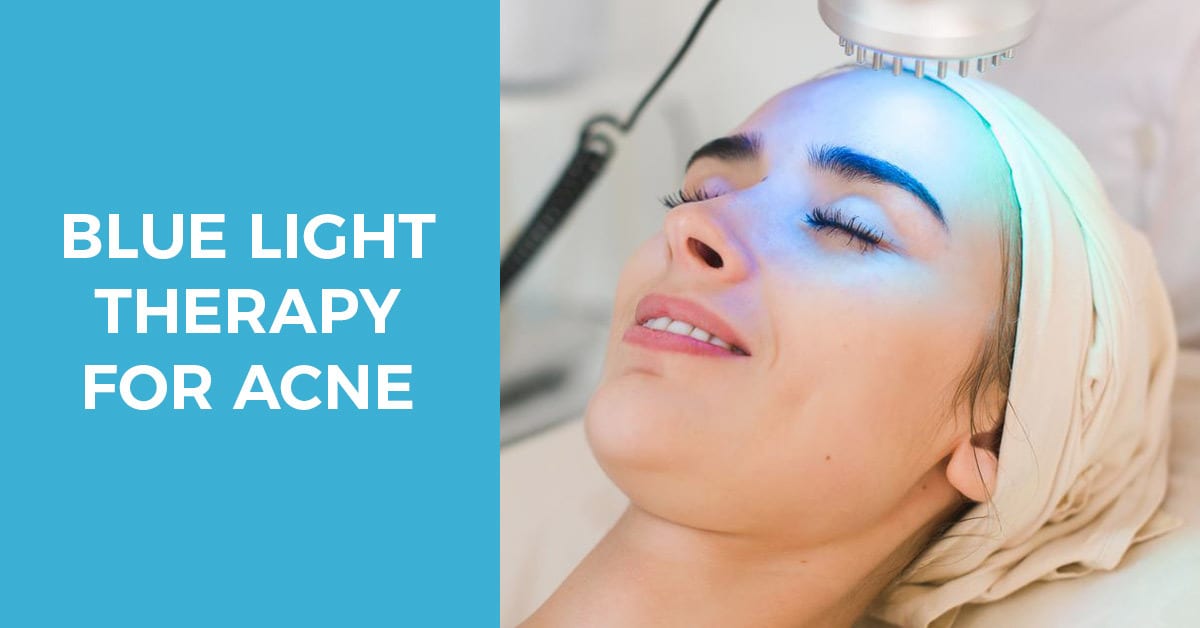Contents
Technological advancements happen in every sphere nowadays, attempting to solve more and more issues to make our lives easier, and skincare isn’t an exception. The fairly recent discovery and adoption of blue light therapy for acne treatment is one such example, which helps deal with acne pretty effectively, while causing technically no side effects.
Let’s take a detailed look at blue light, understand what it is and how it works, how it deals with acne and to expect of the procedures.
What is Blue Light?
Blue light is a high-intensity, narrow band blue light, which is derived from the natural light spectrum and is used to treat various liver diseases, skin conditions like sun damage and prevent skin cancer (it can also remove both cancerous and precancerous skin lesions before they spread to other areas or organs). Blue light is also used to improve skin texture, reduce sebaceous hyperplasia and enlarged oil glands, and help remove sun spots, acne and mild acne scars.

(Blue Light Therapy Procedure)
It’s important to note that blue light therapy makes use of only natural powers and properties of light for its effectiveness (no other ingredients, natural or chemical, are present during this therapy). If any kind of chemical is applied to the skin or ingested, even if it’s to enhance the healing effects, the procedure is no longer called blue light therapy, but photodynamic therapy instead. This difference is important for a few reasons:
- While photodynamic therapy is also an effective acne treatment (in fact, for some people it’s even more effective than blue light alone), the addition chemicals can increase the overall price of the procedure.
- You might be allergic to the chemicals used in photodynamic therapy.
- The side effects of photodynamic therapy are more severe and can get worse if your skin is intolerant to the procedure. The side effects include burning, swelling, itching, redness and crusting.
Properties and Benefits of Blue Light
Blue light therapy brings a ton of healing properties to the table, while carrying little to no side effects at the same time. Here is a list of properties and benefits of blue light:
- FDA approved
- 100% natural
- Chemical and drug free
- Non-invasive (doesn’t utilize needles or knives)
- Non-ablative (doesn’t damage skin)
- Painless
- Safe for all skin types and ages
- No harmful side effects
- Easily used at home
- Kills bad bacteria
- Protects and supports the liver
- Helps regulate mood
How Blue Light Deals with Acne
The blue light treatment therapy makes use of the above mentioned narrow band blue light in the wavelength range of 405-420 nm to kill Propionobacterium acnes (P. acnes) bacteria inside the skin. Blue light therapies are approved by FDA to combat mild to moderate acne breakouts that do not respond to typical, over the counter treatment methods. However, you can undergo blue light therapy even if you haven’t tried any simpler treatment methods before.
The Acne-combating Mechanism

(Types of Acne)
When inside the skin, acne bacteria release porphyrins – naturally occurring substances in our bodies that arise during the synthesis of heme, an iron-containing compound that helps form hemoglobin, in red blood cells. When those porphyrins absorb light at specific wavelengths, such as the blue light, they effectively get eliminated.
During a photodynamic therapy, blue light is used in conjunction with a photosensitizing agent, which makes bacteria even more vulnerable and allows the light to go deeper into the skin, like topical aminolevulinic acid or hydrochloride solution. The pre-treatment with those chemicals helps reduce the size and appearance of pimples even further, but causes severe skin reactions (crusting, burning, itching, redness, etc.) for a few days. Unlike microneedling, both these procedures are non-invasive.
What Are Blue Light Therapy Procedures Like?
Blue light therapy treatments can be done either at home or at the doctor’s office and both variations are pretty easy.
When at the doctor’s office, you usually sit or lie down while a blue light resource is placed near your face for around 30 minutes. In the majority of cases, patients do not experience any discomfort or other symptoms causing them to feel uneasy, and can immediately resume their normal routine after the treatment is done.
When undergoing a photodynamic therapy, the topical agent is usually applied and left on the face for around 20-60 minutes (depending on the severity of the case) before exposing it to blue light. In this case, the exposure lasts for around 10 minutes instead of 30, to avoid any unwelcome reactions.
At-home treatments make use of smaller blue light generators (pens or masks) that can be bought on Amazon and are produced by leading skincare companies like Neutrogena.
Here is a great, explanatory video regarding one such device:
While those carriers are generally weaker compared to the ones at the doc’s office (mainly due to their size and lower intensity of the light to avoid causing any harm to yourself at home), they, too, can be effective. Those carriers are best used to treat smaller (and also a smaller number of) zits, and the procedures should be performed multiple times during the day, with each of them taking around 2-5 minutes.
Results of Blue Light Therapy

(Results of Blue Light Therapy)
Blue light therapy treatments are typically repeated each week and continue for several weeks, maybe months – all depending on the severity of the case. Most people experience significant improvements after four weeks of consistent treatment but its recommended to continue with the procedure until everything has cleared. The downside is that blue light doesn’t guarantee that you won’t have new breakouts in the future after the initial ones have cleared, which practically means that you may have to keep undergoing more procedures to support the achieved results. Not that it’s bad in terms of harmful effects and experiences, but it may very well break the bank.
Photodynamic therapy treatments are generally repeated once every two weeks to allow the full effect of each session to take effect. Those treatments are usually faster to show results compared to blue light alone, but can also be harsh on your skin. The same problem with no guarantees for preventing future breakouts applies to this treatment type as well – you acne may return after some time, which means you’ll need to undergo the same procedure again.
At-home treatments are harmless and need to be performed every day – at least three times (in the morning, in the evening and before going to bed) daily. The small and medium sized zits usually go away after 2-3 days, but the bigger ones can take around 3-5 days. The big upside to this method is, surprisingly, a psychological one. We all know that squeezing pimples does more harm than good, but sometimes, it’s simply impossible to resist the urge. With the light therapy pens at hand though, many users have reported that as long as they perform the treatment and experience (even slight) improvements, it helps them withstand the temptation of popping the pimps, because they know they are doing something that will make them disappear in a few days’ time.
The Cost of Blue Light Therapy
Unfortunately, blue light therapy costs a ton. The price for a single procedure averages $40 and a full treatment package can cost you anywhere between $1000-$1500, depending on your country and severity of the case.
Final Thoughts
Blue light therapy is a very safe, non-invasive way of removing acne from your face and helping your skin recover its sleek shape in a relatively short amount of time (an average of 2 months).
The main downside is the cost of the treatment that is a big obstacle for many people. Adding the part that acne breakouts may return in the future makes it even worse from a budget point of view.
On the other hand, if you have the resources and don’t suffer from painfully severe breakouts, blue light definitely can help regain your confidence and improve social life. If you’re considering this treatment, please remember to consult a professional before doing anything. There is always that small chance of something going horribly wrong (allergic reactions being a prime example), but it can easily be prevented if you just see a dermatologist first.
Have you tried blue light therapy for acne? What are your experiences? How long did it take to start noticing significant improvements? Did your acne return? Share your views and opinions with all of us in the comments!



